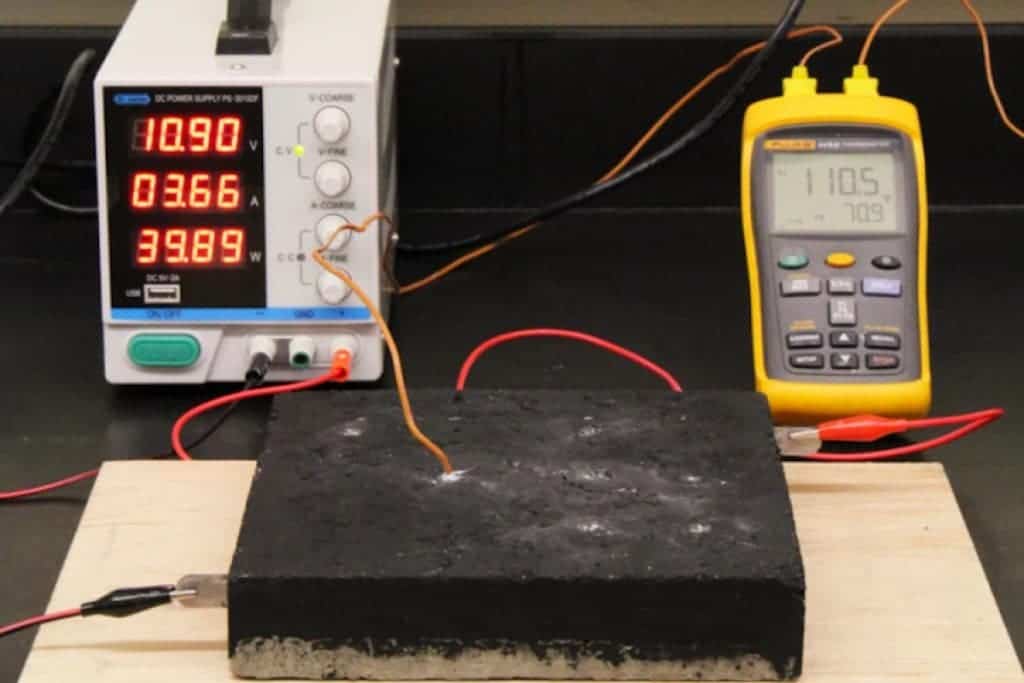
Concrete is such an indispensable construction material that humans invented it twice, more than a thousand years apart. The merit of concrete in supercharging our current infrastructure cannot be overstated, but a group of researchers at MIT still found a way to spice things up.
Normally, concrete is an electrical insulator. But the MIT researchers managed to make it conductive by doping the concrete mixture with nanocarbon black, a very cheap carbon-based material.
Adding just 4% of nanocarbon black to the mixture did the trick, showed experiments carried out by the team led by Nancy Soliman, who is a postdoc at the MIT Concrete Sustainability Hub (CSHub). The ‘black concrete’ could prove useful for a range of new applications that traditionally haven’t been associated with concrete, ranging from energy storage to self-heating.
Electrified concrete
One of the most important contributions of materials science in recent years is the introduction of nanocarbon materials, such as fullerenes, graphene, and carbon nanotubes. The unique structures and novel properties of nanocarbon — chief among them conductivity — have attracted attention not only in terms of their basic science, but also because of their potential applications in many fields, for example, electronics, energy devices, nanocomposites, and biomedical engineering.
But while graphene and carbon nanotubes earn a lot of accolades for their amazing properties, they’re also expensive to manufacture, at least for the time being. Soliman and colleagues turned instead to nanocarbon black or nanopowder, a cheap, environmentally-friendly alternative that is already being used in plastics, coatings, inks, soil fertilizers, and electronics.
A pinch of nanocarbon black was enough to form a nanoparticle network inside the concrete that enabled a functioning circuit. In other words, the added ingredient made the concrete electrically conductive. And due to a physical phenomenon known as the Joule effect, this concrete can also generate heat.
“Joule heating (or resistive heating) is caused by interactions between the moving electrons and atoms in the conductor, explains Nicolas Chanut, a co-author on the paper and a postdoc at MIT CSHub. “The accelerated electrons in the electric field exchange kinetic energy each time they collide with an atom, inducing vibration of the atoms in the lattice, which manifests as heat and a rise of temperature in the material.”

During one experiment, the researchers applied a small voltage (5 volts) to a sample of nanocarbon concrete with a volume of 5 cm3. This demonstration showed that the voltage heated the concrete up to 41 degrees Celsius (around 100 degrees Fahrenheit).
Rather than employing water-based heaters, some residential and commercial buildings could use a form of radiant heating based on electrically conductive concrete. According to the researchers, using the concrete floor as a heart radiator would be cheaper to install and more reliable than conventional heating that requires installing pipes and water heating systems.
The MIT researchers also envision possible outdoor heating applications. For over a hundred years, roads and pavements have been cleared of snow with saline solutions dispensed by heavy-duty trucks. These are expensive to operate and the salt can destroy the concrete pavements in time.
“In North America, we see lots of snow. To remove this snow from our roads requires the use of de-icing salts, which can damage the concrete, and contaminate groundwater,” said Soliman.
Nanocarbon concrete connected to a power supply could de-ice itself without the use of road salt. This could be a particularly appealing solution in those situations where exceptional navigation conditions are paramount, such as airport runways.
The findings appeared in the journal Physical Review Materials.






